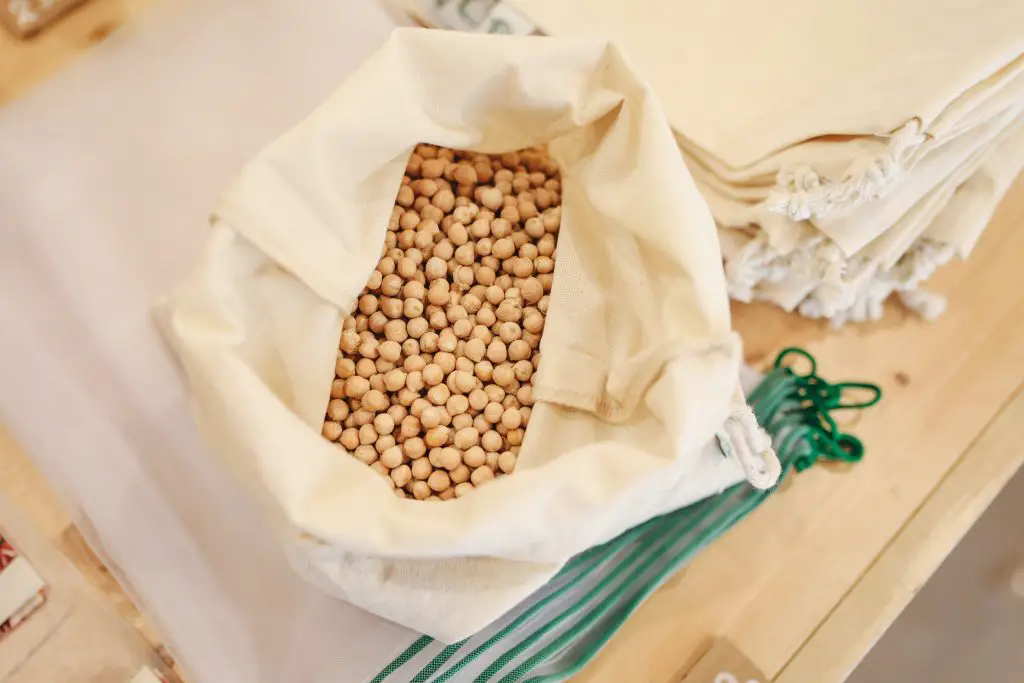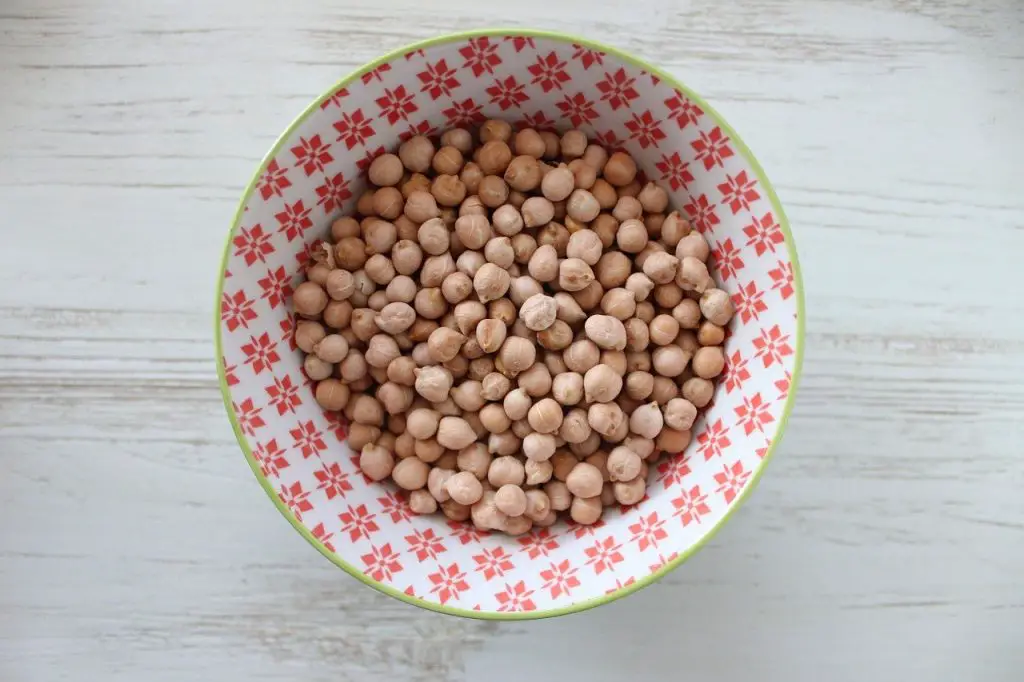
Chickpeas are some of the most delicious and nutritious legumes worldwide; they’re packed with fibre, protein and carbohydrates, and they make fantastic vegan-friendly dinner options. However, cooking dried chickpeas from scratch isn’t always intuitive, so many people wonder whether they can eat chickpeas raw, or undercooked, to make life easier.
You can’t eat dried chickpeas raw because they contain sugars and toxins that make them difficult to digest. Consuming raw chickpeas can lead to stomach aches, digestion problems, and more. However, you can eat canned chickpeas and other tinned legumes without re-cooking them.
What exactly is it that makes raw chickpeas so dangerous to eat? And what’s the best way to cook them, to avoid any digestive issues? I did some research, and this is what I found out.

Can you eat chickpeas and other legumes raw?
We all eat heaps of raw vegetables and fruits, so it’s natural to wonder if you can do the same with chickpeas and other legumes, like beans and lentils. Fresh foods generally promote all sorts of health benefits – but unfortunately, eating raw chickpeas can actually have adverse effects. According to Medical News Today, eating raw chickpeas and other legumes can cause intestinal discomfort – not exactly a desired after-effect of a tasty chickpea salad.
What happens if you eat raw chickpeas and beans?
Let’s take a look at what happens if you consume chickpeas and beans without cooking them properly.
Eating undercooked chickpeas can cause stomach aches
Eating undercooked chickpeas can cause stomach aches, since they contain indigestible sugars called oligosaccharides. I previously covered the discomfort caused by oligosaccharides in an article about why chickpeas can cause stomach problems.
While they’re completely natural, and safe for most people to consume, this type of sugar can cause some people stomach discomfort after eating chickpeas. Cooking chickpeas reduces the amount of oligosaccharides they contain (Rupérez, 1998), which prevents the digestive issues for the majority of people.
Eating raw beans can expose you to lectin
Lectin is a toxin that occurs naturally in all plants, but the highest amounts are found in raw legumes. Lectin consumption can cause stomach aches, nausea, diarrhoea, and more. Luckily, soaking and cooking dried chickpeas destroys active lectins, making them totally safe to eat.

Raw chickpeas can cause bowel movement troubles
Chickpeas are super high in fibre, which we all know is closely connected to the primary function of our bowels (do I really need to spell it out here…?). Eating an excess of fibre may cause you to experience uncomfortable blockages, constipation, gas buildup, and more.
Cooked chickpeas contain just as much fibre as raw chickpeas. However, since even cooked chickpeas can cause discomfort for some people, at least if you make sure they’re thoroughly cooked first, you’ll be limiting any potential issues.
You could damage your teeth
Most dried legumes are rock-hard or excessively crunchy before they’re cooked – so even if raw chickpeas were healthy to eat, they probably wouldn’t be particularly pleasant, or easy to eat. Eating raw chickpeas could chip your teeth, wear down the enamel, and cause jaw joint discomfort.
So… it’s pretty safe to say that eating raw chickpeas is a no-no. Luckily, it’s easy to properly prepare chickpeas and other legumes, to avoid the numerous side effects of eating raw chickpeas and beans. Next time you’re ready to chow down on your favourite legumes, consider the preparation steps below.

How to safely prepare chickpeas
The same digestion problems that can occur after eating raw beans will unfortunately also apply to eating undercooked beans. It’s important to cook chickpeas properly, and thoroughly, to ensure you’re left feeling contentedly full, not uncomfortably bloated.
Here’s how to safely prepare dried chickpeas!
1. Rinse the legumes first
Toss your dried chickpeas in a colander or bowl, and rinse them with warm water to remove natural toxins, preservatives, debris, and pesticides. When they’re thoroughly rinsed, dry them with a couple of paper towels.
2. Next, soak your chickpeas
Place the dried chickpeas in a large pot, and cover them generously in water. Soak them for at least a few hours, or overnight.
One study (Njoumi, Amiot, Rochette, Bellagha & Mouquet-Rivier, 2019) found that soaking actually reduced the amount of bloat-inducing sugars in the chickpeas by 40%! If it’s this sugar that causes your stomach issues after eating chickpeas, I can only imagine how much better you’d feel if your chickpeas contained 40% less of them.
3. Finally, cook them!
If you’re using dried chickpeas, they’ll now need to be thoroughly boiled. Ensure your beans are well cooked by mashing one with a fork or spoon. If it makes a crunch or doesn’t mash, it needs to be cooked a little longer.
Once the chickpeas have been boiled, you can then use them to prepare all sorts of meals. Eat them straight away, add them to a soup or stew, roast them, or whatever else you choose.

Can you eat canned chickpeas without cooking them?
Buying canned chickpeas and other types of canned beans is a great way to skip the first two steps above. Canned legumes are pre-cooked, so you can eat them straight from the tin if you want to – or, dump them straight into your meal. They’re great warm or cold.
Many modern freezer meals also contain chickpeas. These chickpeas will need to be heated through thoroughly before serving (I’m sure I don’t need to tell you not to eat a frozen meal while it’s still frozen!), but they will already be pre-cooked, so it won’t take long.
How to use canned chickpeas
To help reduce the bloat-inducing properties of chickpeas, you should always drain the excess liquid from canned chickpeas and other legumes, especially if you have a history of stomach issues after eating them. They can also be rinsed, to further reduce the amount of sugar, sodium, and preservatives in the can.
The easiest way to drain and rinse a tin of chickpeas is to pour them into a colander to remove the liquid, then run water over the chickpeas until they’re clean. You should follow this suggestion for beans, chickpeas, and any other legumes you come across. Any flavour from the liquid is soaked into them, so you don’t have to worry about losing the taste. You’ll probably be adding plenty of spices or other flavourings to your chickpeas as you cook them, anyway.
Now that you know why you shouldn’t eat raw chickpeas and other undercooked legumes, you can avoid stomach aches and enjoy your favourite foods to your heart’s content. Many legumes are hard to digest if they’re uncooked, so keep that in mind before you eat them – but as long as you know they’ve been properly cooked, dig in!

